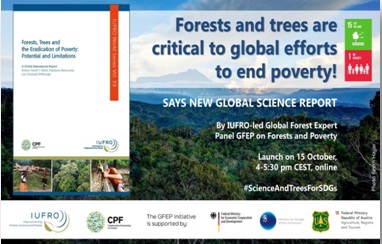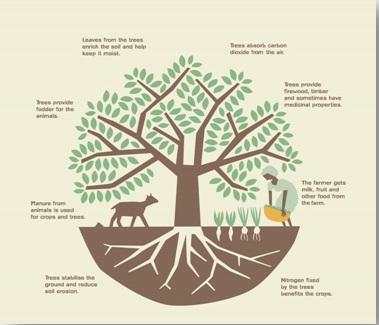

|
Syllabus: Prelims GS Paper I : Current Events of National and International Importance; Economic and Social Development-Sustainable Development, Poverty, Inclusion, Demographics, Social Sector Initiatives, etc. Mains GS Paper II : Issues relating to Poverty and Hunger. |
Context
The Global Forest Expert Panel issued its findings on current environmental challenges, and projected extreme poverty due to COVID 19 pandemic, in a report titled, ‘Forests, Trees and the Eradication of Poverty : Potential and Limitations’.
Background
The report says the vital ecosystem if properly harnessed can transform livelihoods of rural communities amid economic hardships linked to the COVID-19 pandemic. Evidence shows that forests and tree-based systems can support rural livelihoods, have a buffer function in maintaining livelihoods and represent natural insurance.
It emphasised the need of focused attention by governments on sustainable management of forests amid their huge contribution to poverty eradication, food security, and climate resilience. The report was compiled by 22 researchers from nine countries and focused on the link between forests and poverty alleviation successes in Africa, Asia and Latin America during the COVID-19 pandemic era. It is an initiative of the Collaborative Partnership on Forests (CPF) chaired by the Food and Agriculture Organization (FAO) of the United Nations.
Benefits of Agro-forestry
The report highlighted the direct and indirect benefits from forests include forest-related employment and income, use of timber and non-timber forest products, among a wide range of other ecosystem services.
Assessment was based on scientific evidences from countries such as India, Nepal, Costa Rica, Ethiopia, Ivory Coast and Ghana, which showed how agroforestry, community forest management, ecotourism and forest producer organisations have been successful in reducing poverty.
Although, the monetary gains from the ecosystem services may not always reach the poorest households. The benefits and costs from forests and trees to human well-being were unevenly distributed.
For example, community forestry management (CFM) in Nepal recognised as one of the most successful programmes in the world has been critically assessed to show how the better-off households benefitted more than the poorer households.
Further, e.g. in Madagascar, benefits of agroforestry systems focusing on vanilla production were also not distributed equally. Approximately 80 per cent of the world’s vanilla is produced in Madagascar, largely in the north-eastern Sava region. These agroforestry systems are the main source of income for many farmers.
While smallholders who got the contracts flourished, women-headed households were at the disadvantage due to their poor social strata and little chances of getting the contracts, noted the report.
Asia and Africa: Epicenters of Enlarging Inequality
In African continent with rich forests and wildlife biodiversity, timber and tourism contribute massively to national economic accounts. But the benefits may not trickle down to the local level, cautioned experts.
In fact, local communities may bear the cost of these activities through environmental degradation and restricted access to protected areas.
Protected areas did provide opportunities to reduce poverty by involving local people as stakeholders in countries such as Costa Rica and Thailand. Bu the better-off people were more likely to benefit, thus widening the inequality in local income.
When the governmental policies on poverty alleviation have a tendency to focus on agriculture, infrastructure and cash transfers, the report underlined how ecosystem services should be central to global agenda of poverty alleviation and climate mitigation as well.
Underlining major gaps on the linkages between forests and poverty, the report highlighted areas of research that required urgent attention if forests and tree-based systems were to realise their potential in the struggle to end poverty.
It called for more research on the relationship between forests and inequality, which can help inform policymakers of the potential for forests and trees to provide goods and services, manage risk and provide a pathway out of poverty compared with other levers for poverty alleviation.
It noted that nearly 50 per cent of the evidences on linkages between forests and poverty have been documented from just five countries, which are Bangladesh, Brazil, China, India and Nepal. Evidence on agroforestry and poverty also exhibited geographical bias.
Europe, North America and West and Central Africa had not yet been explored completely and the world had limited understanding on ‘forests and livelihood’ in these countries.
Conclusion
Forests and trees are critical to the well-being of many of the world’s poor people who have been able to harness the goods and services they provide to manage and mitigate risk, especially in the face of crises. To secure and improve this important function, we need to adequately protect, manage and restore forests and to make forests and trees more central in policy decision-making.
At least 1.6 billion people are dependent directly on forests for their livelihood most who living below the international poverty line derive direct and indirect benefits from forests. In such a scenario, global assessment offers a new direction and broad well-being opportunities.
Connecting the Article
Question for Prelims : In the context of Agroforestry, consider the following statements:
1. They can control runoff and soil erosion, thereby reducing losses of water, soil material, organic matter and nutrients.
2. Nitrogen-fixing trees and shrubs can substantially increase nitrogen inputs to agro forestry systems.
Which of the statements given above is/are correct ?
(a) 1 only
(b) 2 only
(c) Both 1 and 2
(d) Neither 1 nor 2
Answer (c)
Question for Mains : Agroforestry has a lot in common with intercropping (the practice of planting two or more crops on the same plot) with both practices placing an emphasis on interaction between different plant species. Discuss

Our support team will be happy to assist you!
